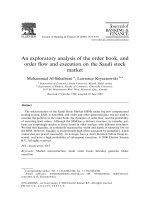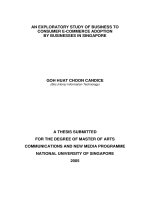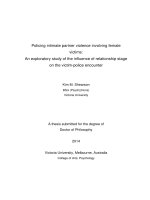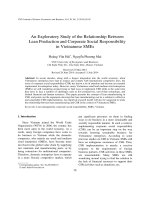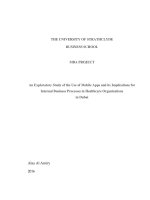An exploratory study of factors towards export and import for march 29 textile garment join stock company
Bạn đang xem bản rút gọn của tài liệu. Xem và tải ngay bản đầy đủ của tài liệu tại đây (1.12 MB, 104 trang )
DUY TAN UNIVERSITY
ECONOMICS – FINANCE
BACHELOR THESIS
MAJOR:
LOGISTICS AND SUPPLY CHAIN MANAGERMENT
AN EXPLORATORY STUDY OF FACTORS
TOWARDS EXPORT AND IMPORT FOR MARCH 29
TEXTILE GARMENT JOIN STOCK COMPANY
Teacher Instructor : Dr. Subhankar Das
Teacher Assistant
: Ms. Nguyen Cao Thuc Uyen
Student
: Huynh Thi Cam
Student’s ID
: 25204716245
Da Nang, 20th May 2023,
ACKNOWLEDGEMENT
To complete my graduation thesis, I would like to express my sincere thanks to the
Board of Directors, the Training Department of the Faculty of Business Administration,
and the lecturers of Duy Tan University for enthusiastically imparting valuable
knowledge to the students. children during their studies at the school and completing the
Graduation Thesis.
Thank you sincerely Dr. Subhankar Das and Ms. Nguyen Cao Thuc Uyen –
The person who directly instructs and guides me during the research and completion of
the graduation thesis.
I would like to thank the Board of Directors, and all of employee at MarchTextile
and Garment Joint Stock Company for their enthusiastic guidance and creating
favorable conditions for me to learn about practice during my internship at the
company. In particular, I would like to thank Mr. Vy, who directly guides, helps and
provides the necessary data for me to complete this graduation thesis.
During the internship at the March Textile Garment Joint Stock Company, I have
cultivated for myself useful knowledge and skills to make a good experience to help me
step forward after graduation. This report is a summary of the knowledge I have learned
during my research at the company. Because of my internship period and limited
knowledge and experience, my report is inevitably flawed. I look forward to receiving
your valuable comments to improve the report.
Thank you sincerely!
Da Nang, May 20,2023
Student
Huynh Thi Cam
DECLARATION or CERTIFICATE
With the topic "An exploratory study of factors towards export and import for
March 29 Textile Garment Join Stock Company", I hereby declare that this is my own
research and under the guidance of Dr. Subhankar Das and Ms. Nguyen Cao Thuc
Uyen. The research content and results in this topic are truthful. The data in the tables
for analysis, comments and evaluation are clearly stated in the reference section. If there
is any problem, I will be responsible for the content of my graduation thesis.
Da Nang, May 20, 2023
Student
Huynh Thi Cam
LIST OF FIGURES
Figure 8.1.1 Model research of Le Ha Phuong (2021).....................................................6
Figure 8.1.2 Model of Tong Thi Anh Ngoc (2019)..........................................................7
Figure 8.1.3 Model research of Wijekoon H. M. S. D, Pathirana H. V. P. K. G,
Fernando H. K. K, and Chandrasekara, N. V (2020).......................................................8
Figure 8.1.4 Model research of Faizal Irvansyah1*, Hermanto Siregar2, Tanti Novianti3
(2017).............................................................................................................................. 9
Figure 8.1.5 Model of Yoganandan.G and Jaganathan AT (2013).................................10
Figure 8.1.6: Model of Wondu Adugna (2018)..............................................................11
Figuge 2.1.1.1 Logo of March 29 Textile Garment Join Stock Company......................16
Figuge 2.4.1 Organization chart of March 29 Textile Garment Join Stock Company....20
Figure 2.12.1.1 Growth rate of net sales and service provision in 2020-2022................38
Figure 2.12.1.2 Growth rate of revenue and profit from 2020-2022..............................38
Figure 4.7.1 Proposed research model...........................................................................66
Figure 4.8.3 Structural model.........................................................................................77
LIST OF TABLE
Table 2.9.1 Labor Structure of March 29 Textile and Garment joint stock company
2020-2021...................................................................................................................... 30
Table 2.10 Situation of assets and capital sources of March 29 textile and garment joint
stock company in the period 2020-2022........................................................................33
Table 2.11.1 Table of export turnover of March 29 Textile and Garment joint stock
company 2020-2022.......................................................................................................35
Table 2.11.2.1 Table of export turnover of March 29 Textile and Garment joint stock
company 2020-2021.......................................................................................................36
Table 2.12.1.1 Business performance report of March 29 Textile Garment Join Stock
company from 2020-2022..............................................................................................37
Table 2.13.1.1 Business performance report of March 29 Textile Garment Join Stock
company from 2020-2022..............................................................................................39
Table 4.2.1 Matrix of factors affecting import and export of textiles.............................51
Table 4.8.1.1 Nominal scale table..................................................................................67
Table 4.8.2.1 Likert Scale table.....................................................................................68
Table 4.7.3.1 Factors affecting Import textiles garment of the sector............................68
Table 4.7.3.2 Factors affecting Export textiles garment of the sector............................69
Table 4.7.3.3 Export factors affect international trade policy........................................69
Table 4.7.3.4 Import factors affect international trade policy........................................70
Table 4.8.1.1 Factor loading for export and import dimensions.....................................71
Table 4.8.1.2 Constructs’ Sources..................................................................................72
Table 4.8.2.1 Model Fit Table........................................................................................73
Table 4.8.2.2 Reliability and validity of Dimension items.............................................74
Table 4.8.2.3 Discriminant validity................................................................................75
Table 4.8.3.1 Model fit for different constructs.............................................................76
TABLE OF CONTENT
PROLOGUE........................................................................................................1
A. INTRODUCTION....................................................................................................................1
1. Research background..................................................................................................................1
2. Research objectives.....................................................................................................................2
3. Research questions...................................................................................................................... 2
4. New contributions of the thesis...................................................................................................2
5. Research object and scope of the study.......................................................................................3
a) Research object of the study........................................................................................................3
b) Research object of the survey....................................................................................................3
c) Research cope of the study..........................................................................................................3
6. Data collection methord..............................................................................................................3
a) Primary data................................................................................................................................ 4
b) Quantitative method.................................................................................................................... 4
7. General topic............................................................................................................................... 4
a) The World................................................................................................................................... 4
b) Asia............................................................................................................................................. 4
c) Vietnam and Danang city............................................................................................................5
8. Related studies............................................................................................................................6
8.1. National research has been published.......................................................................................6
a) Analyzing factor affects the export efficiency of Vietnam's textile and garment to EU
countries - Author: Le Ha Phuong published in 2021.....................................................................6
b) Factors Affecting Textile and Garment Exports from Vietnam - Author: Tong Thi
Anh Ngoc published in the Journal of Economics and Business Research in 2019........................7
8.2. Research abroad has been published........................................................................................7
a) The Study of Factors Affecting Textile and Apparel Exports in Sri Lanka - Author:
Wijekoon H. M. S. D, Pathirana H. V. P. K. G, Fernando H. K. K, and Chandrasekara,
N. V publish in 2020....................................................................................................................... 7
b) The Determinants of Indonesian Textile and Clothing Export to the Five Countries of
Export Destination (Faizal Irvansyah1*, Hermanto Siregar2, Tanti Novianti3)..............................8
c) Studies factors affecting the export performance of textile industry in Developing
Countries – Author: Yoganandan.G and Jaganathan AT (2013)...................................................10
d) Factor affecting the export performance of textile and garment industry in Ethiopia –
Author: Wondu Adugna published in 2018...................................................................................10
9. Structure of topic....................................................................................................................... 11
CHAPTER 1. THEORETICAL BACKGROUND.......................................................................12
1.1. Theoretical basis..................................................................................................................... 12
1.1.1. Define of import and export activities.................................................................................12
1.1.2. The role of import and export activities..............................................................................13
a) For import:................................................................................................................................ 13
b) For export:................................................................................................................................ 14
1.1.3. Factors affecting import and export activities.....................................................................14
a) Global factor............................................................................................................................. 14
b) State and international legal regimes........................................................................................14
c) Transport system, communication............................................................................................15
d) Banking and financial system...................................................................................................15
e) Enterprise and competition in the market..................................................................................15
CHAPTER 2. OVERVIEW OF MARCH 29 TEXTILE GARMENT AND THE
FACTOR TOWARD EXPORT AND IMPORT TEXTILE GARMENT CARGO...............16
2.1. The 3C analysis......................................................................................................................16
2.1.1. Company............................................................................................................................. 16
2.1.1.1. Company detail.................................................................................................16
2.1.1.2. History begins of March 29 Textile Garment Join Stock Company..................17
2.1.2. Customer..............................................................................................................17
2.1.3. Competitor..........................................................................................................................17
2.2. Vision, mission, value............................................................................................................18
2.2.1. Vision.................................................................................................................................. 18
2.2.2. Mission................................................................................................................................ 18
2.2.3. Main business sectors of the company................................................................................19
2.4. Organizational Structure........................................................................................................20
2.4.1. Organizational Structure Overview.....................................................................................20
2.4.2. Function & Duty of the specific department.......................................................................21
2.5. Internal environment of the company.....................................................................................23
2.5.1 Goals of the company...........................................................................................................23
2.5.2. Medium and long term development strategy.....................................................................23
2.5.3. Human Resources of the company......................................................................................24
2.5.4. Production capacity.............................................................................................................24
2.5.5. The reputation of the business is the slogan of the company's activities.............................25
2.6. External environment of the company....................................................................................25
2.6.1. Political environment..........................................................................................................25
2.6.2. Monetary policy..................................................................................................................26
2.6.3. Engineering - Science and Technology...............................................................................26
2.6.4. Factors of society and culture..............................................................................................26
2.7. GAP....................................................................................................................................... 27
2.8. SWOT analysis......................................................................................................................28
2.8.1. Strenght............................................................................................................................... 28
2.8.2. Weakness............................................................................................................................28
2.8.3. Oppoturnity......................................................................................................................... 28
2.8.4. Challenge............................................................................................................................ 29
2.9. Human resources situation of March 29 Textile and Garment Joint Stock Company
...................................................................................................................................................... 29
2.9.1. Structure of human resources..............................................................................................29
2.9.2. Policies for employees........................................................................................................31
2.10. Status of assets and capital of the company..........................................................................33
2.11. Actual situation of the company's export business...............................................................35
2.11.1. Export turnover.................................................................................................................35
2.11.2 Export Market.................................................................................................................... 36
2.12. Analysis the business performance.......................................................................................37
2.12.1. Revenue and market share of each group of products and services...................................37
2.13. Analysis of the company's financial position in the last 3 years...........................................39
CHAPTER 3: Some solutions to improve garment import and export business at march
29 textile and garment joint stock company..................................................................................40
3.1. Orientation for import-export activities of textile and garment joint stock company
29/2 in the future........................................................................................................................... 40
3.1.1. About product quality..........................................................................................................40
3.1.2. Diversify and improve models............................................................................................41
3.1.3. Organizational Structure and Management.........................................................................41
3.1.4. About labor.........................................................................................................................41
3.1.5. About machinery and equipment.........................................................................................42
3.2. Some Solutions to improve garment export business at Textile and garment joint
stock company March 29..............................................................................................................42
3.2.1. Well-organized research and market access........................................................................42
3.2.2. Expanding Relations with foreign partners.........................................................................43
3.2.3. Improving the Quality of business logistics activities.........................................................44
3.3. Conclusions and Recommendations.......................................................................................45
3.3.1. Conclusion.......................................................................................................................... 45
3.3.2. Recommendations to the Government.................................................................................46
3.3.2.1. Investment in infrastructure construction..........................................................46
3.3.2.2. Capital support for Enterprises..........................................................................46
3.3.2.3. Information support..........................................................................................................47
CHAPTER 4: RESEARCH METHODS RESEARCH RESULTS................................48
4.1. Research design and methodology.........................................................................................48
4.1.1. Introduction......................................................................................................................... 48
4.1.2. Research approach............................................................................................................... 48
4.1.3. Research design................................................................................................................... 49
4.1.5. Sampling design.................................................................................................................. 49
4.1.5.1. Target Population..............................................................................................49
a) Sampling Frame........................................................................................................................ 49
b) Sample size............................................................................................................................... 49
4.1.6. Sampling design.................................................................................................................. 50
4.1.6.1. Primary source..................................................................................................50
4.1.6.2. Secondary source..............................................................................................50
4.2 Synthesis of studies of related research models.......................................................................51
4.3 Factors affecting textile and garment export and import.........................................................52
4.3.1. Workforce........................................................................................................................... 52
4.3.2. Technology.......................................................................................................................... 54
4.3.3. Capital................................................................................................................................. 56
4.3.4. Exchange rate......................................................................................................................58
4.4.Export affect international trade policy...................................................................................61
4.5.Import affects international trade policy..................................................................................63
4.6.Research model proposed by the author..................................................................................66
4.7. Building the ladder for research.............................................................................................66
4.7.1. Nominal scale...................................................................................................................... 67
4.7.2. Hierarchical scale................................................................................................................68
4.7.3.Research Questionnaire:.......................................................................................................68
4.7.3.1. Factors affecting Import textiles garment of the sector.....................................68
4.7.3.2. Factors affecting Export textiles garment of the sector.....................................69
4.7.3.3. Export factors affect international trade policy.................................................69
4.8.3.4. Import factors affect international trade policy.................................................70
4.8. Research analysis................................................................................................................... 70
4.8.1. Demographic analysis.........................................................................................................70
4.8.2. Cross validation of Scale.....................................................................................................73
4.8.3. Structural model.................................................................................................................. 75
4.8.4. Discussion........................................................................................................................... 77
4.8.5. Implication of workforce on International Trade Policy......................................................79
4.8.6. Implication of Technology on International Trade Policy...................................................80
4.8.7. Implication of Exchange Rate on International Trade Policy..............................................81
4.8.8. Implication of Capital on International Trade Policy..........................................................82
CHAPTER 5: RECOMMENDATIONS, CONCLUSION............................................84
5.1. Recommendations.................................................................................................................. 84
5.1.1. Quality of technology..........................................................................................................84
5.1.2. Quality of workfore.............................................................................................................86
5.2. Conclusion.............................................................................................................................87
5.4. Limitation of the thesis...........................................................................................................87
QUESTION LIST................................................................................................88
E. REFERENCE.................................................................................................92
INTERNSHIP EVALUATION FORM.....................................................................94
PROLOGUE
A. INTRODUCTION
1. Research background
The textile industry is one of the most important industries globally, contributing
significantly to economic growth and creating millions of jobs. After being impacted
by the COVID-19 pandemic, global textile and garment exports predicted to recover
and expand in 2022-2023.
China, India and Asian countries (particularly Vietnam) are the leading partners
in the world textile industry. The United States, the European Union (EU), and Japan
are the three most significant markets for textile and clothing imports and exports.The
textile and garment export industry's resilience will be dependent on the speed at
which the pandemic recovers and the global development of COVID-19 vaccinations.
New trends such as sustainability are taking over the textile market, which
requires manufacturers to innovate to meet new environmental and social
standards.Threats to the textile industry include competition between producing
countries, changes in trade policies and market fluctuations.
The textile and garment industry in Vietnam has developed strongly in recent
years, becoming the second largest exporter in Asia and receiving investment attention
from many multinational organizations. Vietnam's textile and garment exports have
begun to recover in 2021, despite the pandemic situation. Vietnam's trading partners
include: The United States, the EU, Japan, Korea, China, and ASEAN. The year 20222023 is expected to bring new opportunities for Vietnam's textile and garment
industry, in the context of CPTPP (Comprehensive and Progressive Agreement for
Trans-Pacific Partnership) and EVFTA (Free Trade Agreement between the Alliance)
Europe and Vietnam) to step up trade agreements.
However, in the years to come, Vietnam's textile and garment import and export
sector will confront several new obstacles and challenges as it competes with nations
throughout the region and throughout the world. As a result, the objective of this thesis
is to evaluate and comprehend elements such as economic, political, social, and
cultural aspects that influence the import and export of textiles and garments so that
businesses and governments can come up with well-informed decisions, suitable
strategies, and policies. Furthermore, determining competition between nations and
1
regions in the field of textile import and export to assist market participants in making
proper judgments.
2. Research objectives
General objective:
The general objective of the study is to analyze the factors affecting the import
and export of March 29 Textile and Garment Joint Stock Company in Da Nang city.
From then, some remedies were given based on enhancing the effect of favorable
elements while reducing the influence of negative aspects in order to enhance textile
and garment sector import and export operations.
Detailed objectives:
Contributing to the systematization and development of theoretical foundations,
as well as summarizing practical investigations on variables influencing textile and
garment industry export.
Proposing some suggestions to boost the effect of positive elements while
limiting the influence of negative aspects in order to promote the import and export
activities of March 29 textile and garment joint stock company.
3. Research questions
The thesis aims to answer the following questions:
1. What factors affect textile and garment import and export at the national level?
2. How do economic policies and international trade regulations affect the import
and export of textiles and garments?
3. How is the consumption market changing, and how does it affect import and
export of textiles?
4. What exact factors can explain the volatility of textile imports and export in
the past and the future?
4. New contributions of the thesis
Firstly, the thesis contributes to systematize and supplement the factors affecting
the import and export of textiles and garments of the textile and garment joint stock
company March 29 through building an analytical framework.
Secondly, the thesis points out the factors that positively and negatively affect the
textile and garment export turnover of March 29 joint stock company March 29 in the
2
past years (2021-2023). Based on the analysis of the international context combined
with the limited difficulties in import and export in order to boost the company's
import and export in the coming period.
5. Research object and scope of the study.
a) Research object of the study.
Thesis studies the factors affecting the import and export textiles and garments of
March 29 Textile Garment joint stock companies.
b) Research object of the survey.
Group of employee in March 29 Textile Garment Join Stock Company in Da
Nang
c) Research cope of the study.
About the content: The thesis studies and evaluates the influence levels of factors
on import and export of textile and garment.
To assess the outcomes of textile and clothing import and export operations,
many different criteria can be used such as the output of imported and exported
garments, textile and garment import and export turnover, but the contents are
analyzed and the assessment in the thesis will focus on solutions to boost the textile
and garment import and export turnover of March 29 Textile and Garment Join stock
Company in the near future.
Spatial scope: The study was conducted in Da Nang city.
Time scope: Analysis of factors affecting export and import of textile products at
March Textile and Garment Joint Stock Company in the period of 2021-2023 and
propose solutions for the coming time.
Timeline: 3rd Mar’23 – 7th Apr’23.
6. Data collection methord.
The study use the primary data is mainly combined with qualitative research
method.
a) Primary data
3
Collecting data from previous research articles with the same topic, documents
collected on the internet, research articles from the digital library of Duy Tan
University on sales of products textiles, using data describing the context from
scientific research manuals, newspapers and electronic newspapers, ..
In addition, we also collect research methods from economic experts, lectures on
factors affecting import and export.
b) Quantitative method.
This is a research step conducted with direct interview technique through
questionnaires of import-export sales staff at March 29 Textile and Garment Join
Stock Company. Collected data will be processed by SPSS software are Cronbach's
Alpha reliability evaluation techniques, descriptive statistics analysis, exploratory
factor analysis EFA and linear regression analysis.
7. General topic.
a) The World
The global textile market expected to grew from $573.22 billion in 2022 to
$610.91 billion in 2023 at a compound annual growth rate (CAGR) of 6.6%. The
Russia-Ukraine war disrupted the chances of global economic recovery from the
COVID-19 pandemic, at least in the short term. The war between these two countries
has led to economic sanctions on multiple countries, a surge in commodity prices, and
supply chain disruptions, causing inflation across goods and services and affecting
many markets across the globe.
The countries covered in the textile market are Argentina, Australia, Austria,
Belgium, Brazil, Canada, Chile, China, Colombia, Czech Republic, Denmark, Egypt,
Finland, France, Germany, Hong Kong, India, Indonesia, Ireland, Israel, Italy, Japan,
Malaysia, Mexico, Netherlands, New Zealand, Nigeria, Norway, Peru, Philippines,
Poland, Portugal, Romania, Russia, Saudi Arabia, Singapore, South Africa, South
Korea, Spain, Sweden, Switzerland, Thailand, Turkey, UAE, UK, USA, Venezuela,
Vietnam.
b) Asia
Asia is the potential market for textile industry, and Asia-Pacific is the leading
region in the global textile yarn market, followed by North America, while China is
the major exporter with total share of 37 percent in the global trade of textile & apparel
4
sector followed by other countries like India, Bangladesh, Indonesia, Vietnam &
Cambodia
c) Vietnam and Danang city
Although the garment segment has grown in production and exports, there are
signs of slowing down. In November 2022, Vietnam's garment export value was
estimated at $2.85 billion, down 6.4% along with period and 34.6 billion USD, up
18.7% year on year.
Garment manufacturing activity continued to slow down in November when the
index of industrial production (IIP) in November 2022 increased by 2.2% and 16.4
respectively over the same period.
For the yarn segment, exports and tieeos production continued to decline. Yarn
export value in November and 11 months of 2022 was estimated at USD 227 million,
down 45.9% over the same period and down 14.1% over the same period last year.
Textile production also declined. Specifically, textile IIP in November 2022 is
estimated to decrease by 1.9% over the same period.
According to statistics of the General Department of Customs, the total export
turnover of Vietnam's textile and garment products and related products to the markets
of Europe and America by the end of September 2022 reached 20.35 billion USD. an
increase of 27.3% over the same period in 2021.
In which, exports of textiles and garments reached more than 19.3 billion USD,
up 24.7%; Export of raw materials for textile, garment and leather, shoes reached
about 354 million USD, up 27.9%; Export of textile fibers and yarns of all kinds
reached USD 366 million, up 21.6%; exports of drapery and other technical fabrics
reached US$296 million, up 24.2%.
Export of textiles and related products to the Europe - America region currently
accounts for about 59% of the total export value of this item of Vietnam to the world.
In which, exports to the US market accounted for 42%, and the EU accounted for 10%.
For Danang city, according to the Department of Industry and Trade, in 2022, the
city's export turnover of goods is estimated at nearly $2.08 billion. In which, the textile
and garment industry always has a high export turnover and grows to 532 million USD
and up 13.4% compared to 2021.
8. Related studies
5
8.1. National research has been published
a) Analyzing factor affects the export efficiency of Vietnam's textile and garment to EU
countries - Author: Le Ha Phuong published in 2021
This thesis deals with the factors affecting the export efficiency of Vietnam's
textile and garment industry to countries in the European Union (EU). The author has
analyzed factors such as product quality, production costs, competition with other
countries, International trade policies, and consumer markets. The author has carried
out the research by analyzing statistics on exports of the textile and garment industry
from Vietnam to EU countries for many years. Research results shows that improving
the export efficiency of Vietnam's textile and garment sector to the EU requires
improving product quality, improving manufacturing methods, expanding consumer
markets, and using new technologies.
Figure 8.1.1 Model research of Le Ha Phuong (2021)
b) Factors Affecting Textile and Garment Exports from Vietnam - Author: Tong Thi
Anh Ngoc published in the Journal of Economics and Business Research in 2019.
The article "Factors affecting Vietnam's textile and garment exports" by Tong
Thi Anh Ngoc explores the different factors that have contributed to the success of
Vietnam's textile industry. Based on a literature review and interviews with industry
experts, the paper factors such as International trade policy, investment in machinery
6
and technology, access to raw materials, and the workforce. Skilled workers are the
main contributors to the increase in Vietnam's exports in this area. The article also
discusses challenges facing the industry such as high competition, volatile global
demand, and trade barriers. The authors conclude that Vietnam's textile and apparel
exports are expected to continue to grow in the future, but the industry must continue
to focus on innovation and upgrading its operations to remain competitive.
Figure 8.1.2 Model of Tong Thi Anh Ngoc (2019)
8.2. Research abroad has been published
a) The Study of Factors Affecting Textile and Apparel Exports in Sri Lanka - Author:
Wijekoon H. M. S. D, Pathirana H. V. P. K. G, Fernando H. K. K, and
Chandrasekara, N. V publish in 2020
According to this research, revealing that exchange rate volatility has a
significant negative impact on the export volume for textiles and garments, this
study concludes that the rising exchange rate does not have an opposing
influence on textile and apparel exports. As depicted in the results, the other
factor that affects textile and apparel exports is the import of textile raw
materials. Finally, this study concludes that textile imports and exchange rates
positively influence the textile and apparel exports of Sri Lanka in the short run.
However, all the desired explanatory variables including the apparel production
index, textile imports, clothing imports, and exchange rate have a long-run
relationship with textile and apparel exports.
7
Research Hypotheses of the study
H1: There is a significant impact of the apparel production index on textile and
apparel exports
H2: There is a significant impact of textile imports on textile and apparel exports
H3: There is a significant impact of clothing imports on textile and apparel
exports
H4: There is a significant impact of the exchange rate on textile and apparel
exports
Figure 8.1.3 Model research of Wijekoon H. M. S. D,
Pathirana H. V. P. K. G, Fernando H. K. K, and
Chandrasekara, N. V (2020)
b) The Determinants of Indonesian Textile and Clothing Export to the Five Countries
of Export Destination (Faizal Irvansyah1*, Hermanto Siregar2, Tanti Novianti3)
This study focuses on the determinants of Indonesian fabric and clothing exports
to five major exporting countries, the United States, Japan, the People's Republic of
China, South Korea, and Turkey in 2017. In this study, the models of factors affecting
exports are gross domestic product (GDP) per capita and exchange rates. Furthermore,
several factors also influence exports, specifically product prices and import tariffs.
8

